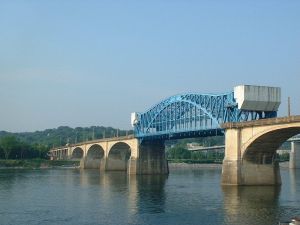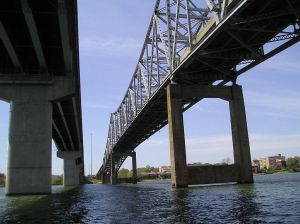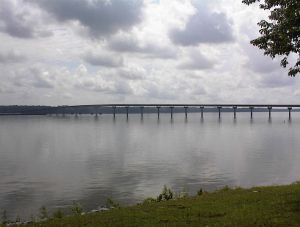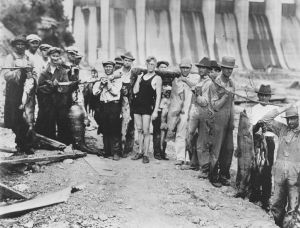Tennessee River
| Tennessee River | |
|---|---|
| | |
| Origin | Confluence of French Broad and Holston at Knoxville. |
| Mouth | Ohio River at Paducah, Kentucky |
| Basin countries | USA |
| Length | 652 mi (1049 km)[1] |
| Source elevation | 813 ft (248 m)[2] |
| Mouth elevation | 302 ft (92 m)[3] |
| Avg. discharge | 70,575 ft3/s (2,000 m³/s)[4] |
| Basin area | 40,876 mi² (105,870 km²)[4] |
The Tennessee River is the largest tributary of the Ohio River. It is approximately 652 miles (1049 km) long and is located in the southeastern United States in the Tennessee Valley. The river was once popularly known as the Cherokee River, among other names.[1] The river has been dammed numerous times, primarily by Tennessee Valley Authority (TVA) projects which began as part of the New Deal to help financial recovery after the Great Depression. The placement of TVA's Kentucky Dam on the Tennessee River and the Corps' Barkley Dam on the Cumberland River directly led to the creation of Land Between the Lakes. The TVA is the nation's largest public power company. Cheap transport along the River helped to develop the economy of the State of Tennessee. Many of the towns and cities along its banks and their industries owe their existence to the river. It is navigable for 652 miles. Some 17,000 recreational craft each year pass along the river, which is used for leisure and for pleasure as well as for profit.[5]
Course
The Tennessee River is formed at the confluence of the Holston and French Broad Rivers on the east side of Knoxville, Tennessee. From Knoxville, it flows southwest through East Tennessee toward Chattanooga before crossing into Alabama. It loops through northern Alabama and eventually forms a small part of the state's border with Mississippi, before returning to Tennessee. At this point, it defines the boundary between Tennessee's other two regions—Middle and West Tennessee. The Tennessee-Tombigbee Waterway, a U.S. Army Corps of Engineers project providing navigation on the Tombigbee River and a link to the Port of Mobile, enters Tennessee near the Tennessee-Alabama-Mississippi boundary. This waterway reduces the navigation distance from Tennessee, north Alabama, and northern Mississippi to the Gulf of Mexico by hundreds of miles. The final part of the Tennessee's run is in Kentucky, where it separates the Jackson Purchase from the rest of the state. It then flows into the Ohio River at Paducah, Kentucky. It is one of a very few rivers in the United States which leave a state and then re-enter it; the Cumberland River is another such river.
Dams
The river has been dammed numerous times, primarily by Tennessee Valley Authority (TVA) projects. The placement of TVA's Kentucky Dam on the Tennessee River and the Corps' Barkley Dam on the Cumberland River directly led to the creation of Land Between the Lakes. A navigation canal located at Grand Rivers, Kentucky links Kentucky Lake and Lake Barkley. The canal allows for a shorter trip for river traffic going from the Tennessee to most of the Ohio River, and for traffic going down the Cumberland River toward the Mississippi.
Important cities and towns
Cities in bold type contain over 30,000 residents
- Bridgeport, Alabama
- Chattanooga, Tennessee
- Cherokee, Alabama
- Clifton, Tennessee
- Crump, Tennessee
- Decatur, Alabama
- Florence, Alabama
- Grand Rivers, Kentucky
- Guntersville, Alabama
- Harrison, Tennessee
- Huntsville, Alabama
- Killen, Alabama
- Knoxville, Tennessee
- Lakesite, Tennessee
- Langston, Alabama
- Lenoir City, Tennessee
- Loudon, Tennessee
- New Johnsonville, Tennessee
- Paducah, Kentucky
- Redstone Arsenal, Alabama
- Saltillo, Tennessee
- Savannah, Tennessee
- Scottsboro, Alabama
- Sheffield, Alabama
- Soddy-Daisy, Tennessee
- Signal Mountain, Tennessee
- South Pittsburg, Tennessee
- Triana, Alabama
- Waterloo, Alabama
Historic beginning
Although the headwaters of the Tennessee River have changed many times over the years, and today officially begin at mile post 652 where the French Broad River meets the Holston River, the Tennessee River did not originally begin there. Until 1933, the Holston River flowed past Knoxville and continued to its confluence with the Little Tennessee River at Lenoir City 51 miles downstream. At that point, the Tennessee River began, 601 miles upstream from the Ohio River at Paducah, Kentucky. The reason was a federal mandate that the Tennessee River flow past the newly-established headquarters of the Tennessee Valley Authority in downtown Knoxville, Tennessee. For that reason, the headwaters of the Tennessee were established upstream at the confluence of the Holston and French Broad Rivers.
According to Tennessee Valley Authority historians, the reason for changing the Tennessee River headwaters once again, was that when the Tennessee Valley Authority was created in 1933, Congress mandated that, since the TVA headquarters were to be in downtown Knoxville, and from the headquarters, the federal agency would manage all the dams and flood control on the Tennessee River and its tributaries, the TVA headquarters had to be located on the banks of the Tennessee River itself. For that reason, the headwaters of the Tennessee River were moved from Lenoir City 51 miles upstream past downtown Knoxville, to the confluence of the Holston and the French Broad Rivers, to fulfill the Congressional mandate for creation of the Tennessee Valley Authority.
Popular culture
- Cormac McCarthy's 1979 novel Suttree concerns a man who forsakes his life of privilege to become a fisherman along the Tennessee River in Knoxville in the early 1950s.
- The song "Tennessee River" was recorded by the country music band Alabama in 1980.
Tennessee River tributaries
Tributaries and sub-tributaries are hierarchically listed in order from the mouth of the Tennessee River upstream.
- Big Sandy River (Tennessee)
- Duck River (Tennessee)
- Buffalo River (Tennessee)
- Piney River (Tennessee)
- Beech River (Tennessee)
- Bear Creek (Alabama, Mississippi)[6]
- Buzzard Roost Creek (Alabama)[6]
- Colbert Creek (Alabama)[6]
- Malone Creek (Alabama)[6]
- Mulberry Creek (Alabama)[6]
- Cane Creek (Alabama)[6]
- Dry Creek (Alabama)[6]
- Little Bear Creek (Alabama)[6]
- Spring Creek (Alabama)[7]
- Cypress Creek (Alabama)[7]
- Shoal Creek (Alabama)[7]
- First Creek (Alabama)[7]
- Elk River (Tennessee, Alabama)
- Flint Creek (Alabama)
- Limestone Creek (Alabama, Tennessee)
- Beaverdam Creek (Alabama)
- Indian Creek (Alabama)
- Barren Fork Creek
- Flint River (Alabama, Tennessee)
- Paint Rock River (Alabama, Tennessee)
- Sequatchie River (Tennessee)
- Hiwassee River (Tennessee, North Carolina)
- Conasauga Creek (Tennessee)
- Ocoee River (Tennessee, Georgia)
- Nottely River (North Carolina, Georgia)
- Piney River (Tennessee)
- Clinch River (Tennessee, Virginia)
- Emory River (Tennessee)
- Obed River (Tennessee)
- Powell River (Tennessee, Virginia)
- Emory River (Tennessee)
- Little Tennessee River (Tennessee, North Carolina)
- Tellico River (Tennessee)
- Tuckaseegee River
- Nantahala River (North Carolina)
- Cullasaja River (North Carolina)
- Little River (Tennessee)
- French Broad River
- Little Pigeon River (Tennessee)
- Nolichucky River (Tennessee, North Carolina)
- Pigeon River (Tennessee, North Carolina)
- Holston River (Tennessee)
- North Fork Holston River (Tennessee, Virginia)
- South Fork Holston River (Tennessee, Virginia)
- Watauga River (Tennessee, North Carolina)
- Doe River (Tennessee)
- Watauga River (Tennessee, North Carolina)
- Middle Fork Holston River (Virginia)
Notes
- ↑ 1.0 1.1 USGS, Geographic Names Informaion System Feature Detail Report - Tennessee River, USGS GNIS: Tennessee River Retrieved January 28, 2008.
- ↑ U.S. Geological Survey, Shooks Gap quadrangle, Tennessee. 1:24,000. 7.5 Minute Series (Washington D.C.: USGS, 1987).
- ↑ U.S. Geological Survey, Paducah East quadrangle, Kentucky. 1:24,000. 7.5 Minute Series (Washington D.C.: USGS, 1982).
- ↑ 4.0 4.1 Arthur Benke and Colbert Cushing, Rivers of North America (Boston: Elsevier Academic Press, 2005).
- ↑ "Navigation on the Tennessee River," TVA Navigation on the Tennessee River Retrieved January 28, 2008.
- ↑ 6.0 6.1 6.2 6.3 6.4 6.5 6.6 6.7 Alabama Department of Transportation, County Highway Maps, County Highway Maps Retrieved January 28, 2008.
ReferencesISBN links support NWE through referral fees
- Alabama Department of Transportation. County Highway Maps. County Highway Maps Retrieved January 28, 2008.
- Army Corp of Engineers. Tennessee River Navigation. Tennessee River Navigation Retrieved January 28, 2008.
- Benke, Arthr, and Colbert Cushing. Rivers of North America. Boston: Elsevier Academic Press, 2005. ISBN 0-12-088253-1
- U.S. Geological Survey. Geographic Names Informaion System Feature Detail Report - Tennessee River. USGS GNIS: Tennessee River Retrieved January 28, 2008.
- U.S. Geological Survey. Paducah East quadrangle, Kentucky. 1:24,000. 7.5 Minute Series. Washington D.C.: USGS, 1982.
- U.S. Geological Survey. Shooks Gap quadrangle, Tennessee. 1:24,000. 7.5 Minute Series. Washington D.C.: USGS, 1987.
Credits
New World Encyclopedia writers and editors rewrote and completed the Wikipedia article in accordance with New World Encyclopedia standards. This article abides by terms of the Creative Commons CC-by-sa 3.0 License (CC-by-sa), which may be used and disseminated with proper attribution. Credit is due under the terms of this license that can reference both the New World Encyclopedia contributors and the selfless volunteer contributors of the Wikimedia Foundation. To cite this article click here for a list of acceptable citing formats.The history of earlier contributions by wikipedians is accessible to researchers here:
The history of this article since it was imported to New World Encyclopedia:
Note: Some restrictions may apply to use of individual images which are separately licensed.





